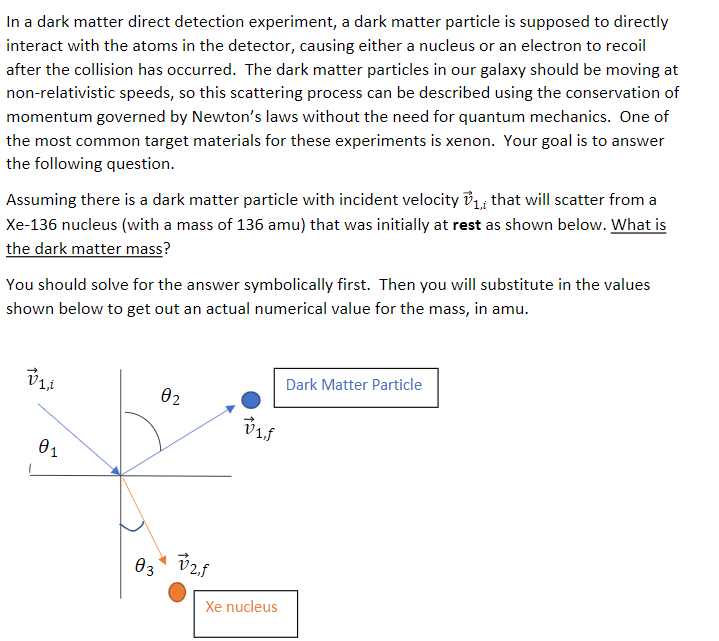In a dark matter direct detection experiment, a dark matter particle is supposed to directly interact with the atoms in the detector, causing either a nucleus or an electron to recoil after the collision has occurred. The dark matter particles in our galaxy should be moving a non-relativistic speeds, so this scattering process can be described using the conservation o momentum governed by Newton's laws without the need for quantum mechanics. One of the most common target materials for these experiments is xenon. Your goal is to answer the following question. Assuming there is a dark matter particle with incident velocity v1 that will scatter from a Xe-136 nucleus (with a mass of 136 amu) that was initially at rest as shown below. What is the dark matter mass? You should solve for the answer symbolically first. Then you will substitute in the values shown below to get out an actual numerical value for the mass, in amu. Dark Matter Particle 02 P.
In a dark matter direct detection experiment, a dark matter particle is supposed to directly interact with the atoms in the detector, causing either a nucleus or an electron to recoil after the collision has occurred. The dark matter particles in our galaxy should be moving a non-relativistic speeds, so this scattering process can be described using the conservation o momentum governed by Newton's laws without the need for quantum mechanics. One of the most common target materials for these experiments is xenon. Your goal is to answer the following question. Assuming there is a dark matter particle with incident velocity v1 that will scatter from a Xe-136 nucleus (with a mass of 136 amu) that was initially at rest as shown below. What is the dark matter mass? You should solve for the answer symbolically first. Then you will substitute in the values shown below to get out an actual numerical value for the mass, in amu. Dark Matter Particle 02 P.
Classical Dynamics of Particles and Systems
5th Edition
ISBN:9780534408961
Author:Stephen T. Thornton, Jerry B. Marion
Publisher:Stephen T. Thornton, Jerry B. Marion
Chapter14: Special Theory Of Relativity
Section: Chapter Questions
Problem 14.41P
Related questions
Question

Transcribed Image Text:In a dark matter direct detection experiment, a dark matter particle is supposed to directly
interact with the atoms in the detector, causing either a nucleus or an electron to recoil
after the collision has occurred. The dark matter particles in our galaxy should be moving at
non-relativistic speeds, so this scattering process can be described using the conservation of
momentum governed by Newton's laws without the need for quantum mechanics. One of
the most common target materials for these experiments is xenon. Your goal is to answer
the following question.
Assuming there is a dark matter particle with incident velocity v1 that will scatter from a
Xe-136 nucleus (with a mass of 136 amu) that was initially at rest as shown below. What is
the dark matter mass?
You should solve for the answer symbolically first. Then you will substitute in the values
shown below to get out an actual numerical value for the mass, in amu.
Dark Matter Particle
02
01
Өз
Xe nucleus
Expert Solution
This question has been solved!
Explore an expertly crafted, step-by-step solution for a thorough understanding of key concepts.
This is a popular solution!
Trending now
This is a popular solution!
Step by step
Solved in 2 steps with 1 images

Recommended textbooks for you

Classical Dynamics of Particles and Systems
Physics
ISBN:
9780534408961
Author:
Stephen T. Thornton, Jerry B. Marion
Publisher:
Cengage Learning

Modern Physics
Physics
ISBN:
9781111794378
Author:
Raymond A. Serway, Clement J. Moses, Curt A. Moyer
Publisher:
Cengage Learning

University Physics Volume 1
Physics
ISBN:
9781938168277
Author:
William Moebs, Samuel J. Ling, Jeff Sanny
Publisher:
OpenStax - Rice University

Classical Dynamics of Particles and Systems
Physics
ISBN:
9780534408961
Author:
Stephen T. Thornton, Jerry B. Marion
Publisher:
Cengage Learning

Modern Physics
Physics
ISBN:
9781111794378
Author:
Raymond A. Serway, Clement J. Moses, Curt A. Moyer
Publisher:
Cengage Learning

University Physics Volume 1
Physics
ISBN:
9781938168277
Author:
William Moebs, Samuel J. Ling, Jeff Sanny
Publisher:
OpenStax - Rice University

Principles of Physics: A Calculus-Based Text
Physics
ISBN:
9781133104261
Author:
Raymond A. Serway, John W. Jewett
Publisher:
Cengage Learning